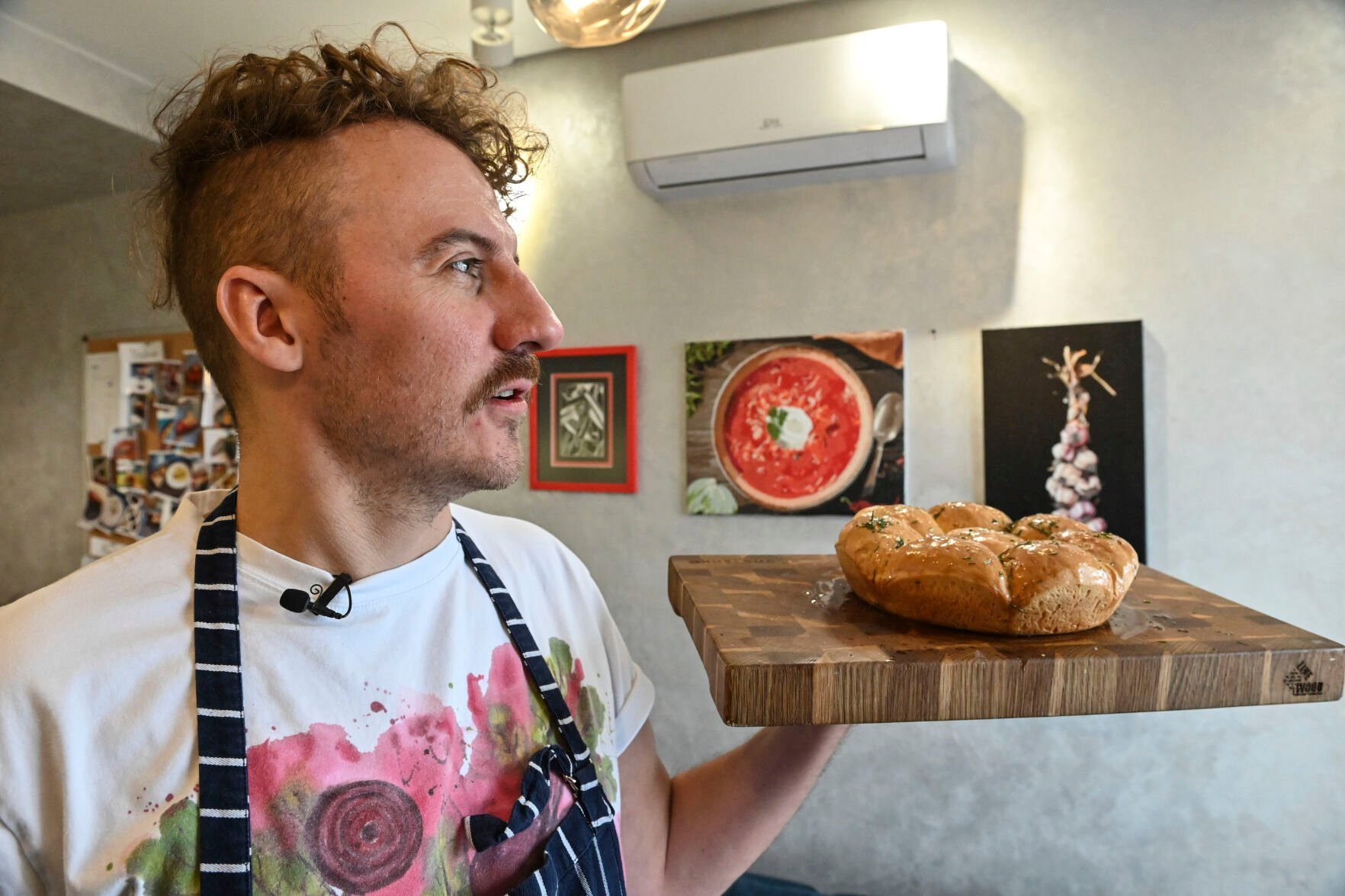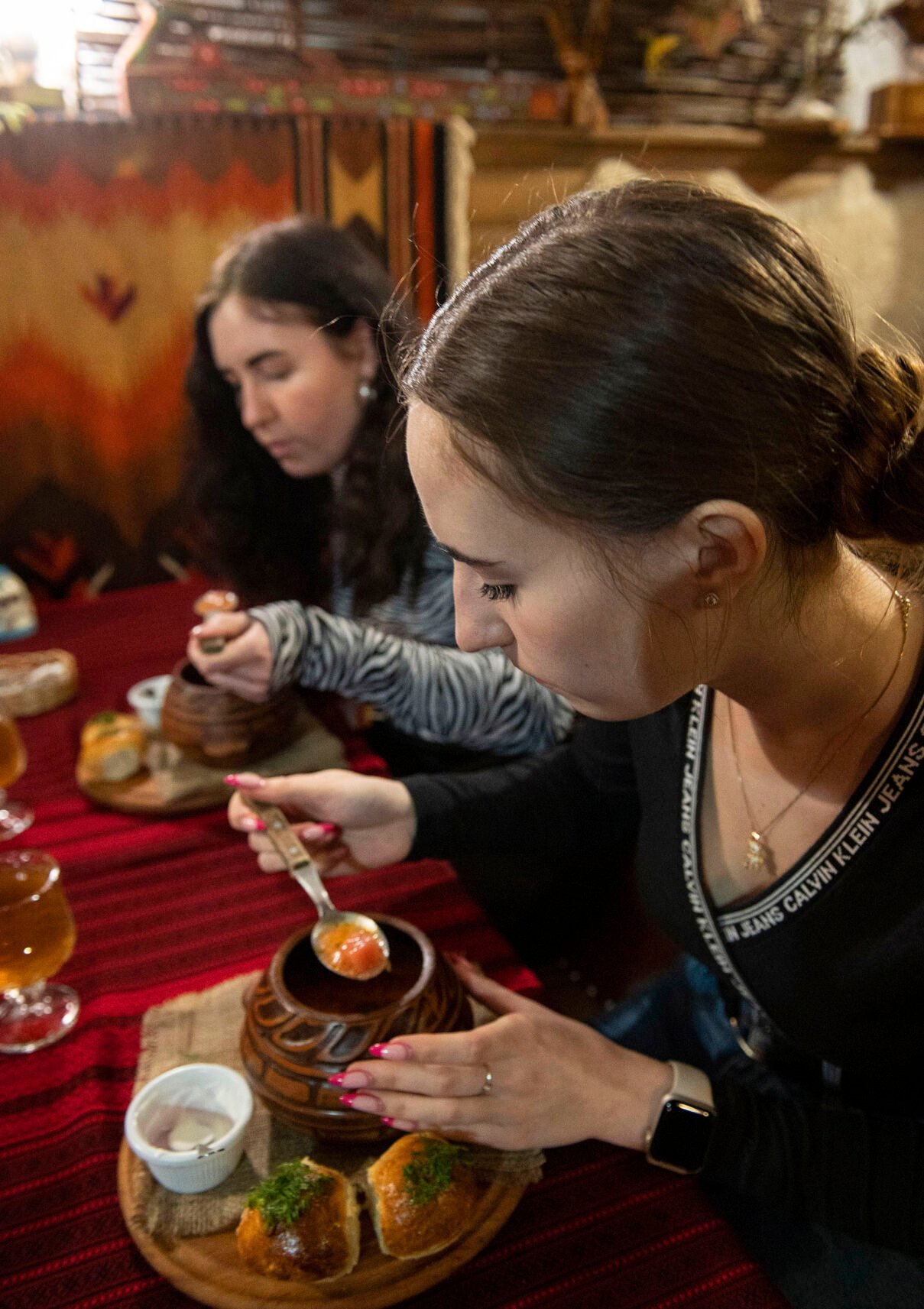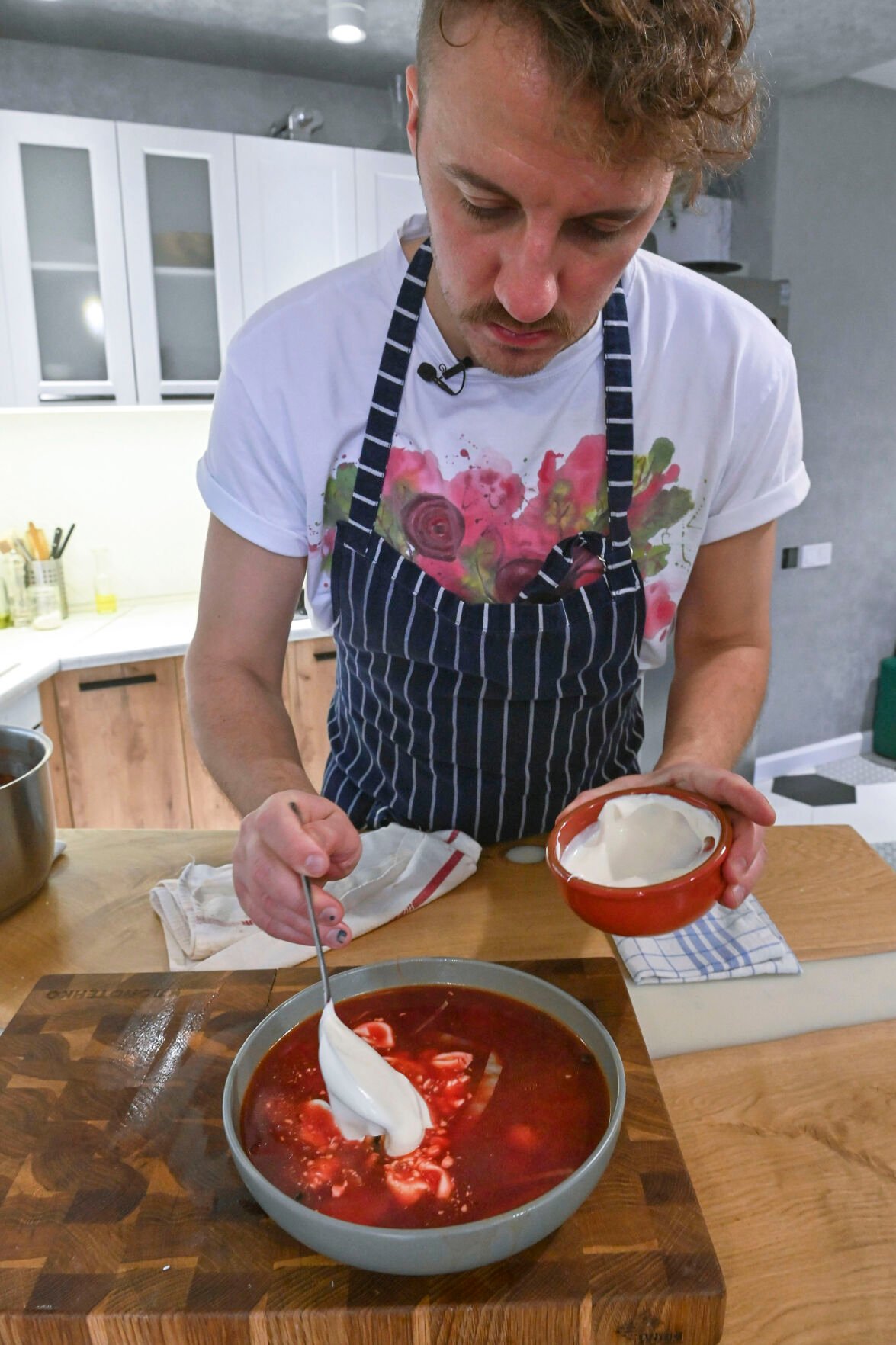KYIV, Ukraine — Don’t tell Ievgen Klopotenko that borsch is just food. For him, that bowl of beet-and-meat soup is the embodiment of everything Ukraine is fighting for.
“Food is a powerful social instrument by which you can unite or divide a nation,” said Klopotenko, Ukraine’s most recognizable celebrity chef and the man who in the midst of a bloody war spearheaded what would become an unlikely cultural victory over Russia.

Chris Warde-Jones, Associated Press
Ukrainian chef Ievgen Klopotenko poses with a tray of Pampushky bread in his kitchen on Feb. 5 in Kyiv, Ukraine.
“It’s our symbol,” Klopotenko said. “Borsch is our leader.”
If that seems hyperbolic, you underestimate how intrinsic borsch (the preferred Ukrainian spelling) is to this country’s soul. More than a meal, it represents history, family and centuries of tradition. It is eaten always and everywhere, and its preparation is described almost reverentially.
And now, at the one-year mark of the war with Russia, Klopotenko uses the dish as a rallying call for preserving Ukrainian identity. It’s an act of culinary defiance against one of Moscow’s widely discredited justifications of the war — that Ukraine is culturally indistinct from Russia.
Thanks to a lobbying effort that Klopotenko helped lead, UNESCO issued a fast-track decision last July declaring Ukrainian borsch an asset of “intangible cultural heritage” in need of preservation. Although the declaration noted borsch is consumed elsewhere in the region, and that no exclusivity was implied, the move infuriated Russia.

Chris Warde-Jones, Associated Press
A customer eats borsch on Feb. 9 in a restaurant in central Kyiv, Ukraine on Thursday, Feb. 9, 2023. Borsch was declared an asset of "intangible national heritage" by UNESCO in July 2022, a decision which helped put Ukrainian food on the map.
A Russian foreign ministry spokesperson accused Ukraine of appropriating the dish and called the move an act of xenophobia and Nazism.
But in Ukraine, where until a year ago Russian was as widely spoken as Ukrainian, the declaration legitimized a notion that many had struggled to express.
“People started to understand that they are Ukrainians,” Klopotenko said recently while preparing borsch at his Kyiv apartment. From his living room window, the husk of a high-rise gutted by Russian missiles dominated the view.
“A lot of people started to eat Ukrainian food. A lot of people began to discover Ukrainian traditions,” he said.
Klopotenko, 36, is an unlikely figure to grab headlines during a war that has left hundreds of thousands from all sides dead or wounded. But the television chef and restaurateur — recognizable by an unruly head of curls, rapid-fire dialogue and lively fashion sense — began his mission to elevate Ukrainian food years before Russia’s invasion in February 2022.
Though born in Kyiv, Klopotenko had by age 5 spent months at a time living with his grandmother, who had moved just outside Manchester, England. He’d been raised on bland Soviet-era cuisine, and this was a culinary awakening. He encountered waves of new flavors and ingredients, experiences that set him on a path to restaurant work.
His break came in 2015 when he won the television competition “MasterChef Ukraine.” He parlayed that into study at Le Cordon Bleu in Paris and later a successful campaign to overhaul the Soviet-influenced cafeteria menus in Ukrainian schools.
Always in the background was his sense that Ukrainian food — ditto the country’s culture writ large — wasn’t being true to itself. Much of Ukraine’s identity, he felt, from language and food to fashion and architecture, had been subjugated to Russian influences. Before the start of Soviet rule in 1917, Ukrainian cuisine was more diverse and robustly seasoned. That was quashed in favor of a more uniform palate with socialist sensibilities.
Even after the dissolution of the USSR in 1991, Ukraine’s cuisine didn’t quite bounce back. But Russia’s invasion and annexation of Crimea from Ukraine in 2014 was a trigger. Trying to identify and hold onto Ukrainian heritage, Klopotenko and others began researching pre-Soviet Ukrainian cooking, hoping to return it to the mainstream and give people another toehold for reclaiming their culture.
In 2019, he opened his Kyiv restaurant, 100 Rokiv Tomu Vpered (100 Years Ago Ahead), a reference to what Ukrainian cuisine was before Soviet rule, and what it could be again. The menu draws heavily on flavors and ingredients many have forgotten.

Chris Warde-Jones, Associated Press
Ukrainian chef Ievgen Klopotenko adds sour cream to borsch on Feb. 5 in his home in Kyiv, Ukraine.
Roasted parsnips with smoked sour cream. Buckwheat bread flavored with chamomile. Banosh, a sort of corn porridge topped with cottage cheese, mushrooms and apples.
And, of course, borsch seasoned with the traditional smoked pears. Written records tie the recipe to Ukraine over many centuries. The effort to have it declared a cultural asset began in 2018, when Klopotenko enlisted the help of Maryna Sobotiuk, an adviser to the Ukrainian Ministry of Information Policy and co-founder of the Institute of Culture of Ukraine.
They assembled a dossier that would become the country’s application to UNESCO. Their work took on greater urgency after Russia’s invasion a year ago and received the blessing of Ukraine’s government.
Like Klopotenko, Sobotiuk said it’s a cause much deeper than dinner.
“Our neighbors want to not just take our territory, but also our culture and our history,” she said, calling culinary heritage a soft power with tremendous potential to motivate and inspire. “It is important to give people something they can align with Ukraine except war.”
-
Too much Southern-style food can cause sudden heart attack, study says
Fatih Ispir/Getty Images
Unfortunately, Americans are notorious for not making the healthiest eating choices. Research has shown that eating healthy isn’t a series of diet-centered choices, but rather the aggregated results of small habits performed consistently. That’s where other cultures come in. Some places around the world such as Okinawa and Sardinia are famous for the longevity of their residents, and Americans can take some cues from their practices around eating, cooking and more. If you’re looking to shake up your routine, consider incorporating some of these healthy eating habits from other cultures around the world.
Fatih Ispir/Getty Images
Unfortunately, Americans are notorious for not making the healthiest eating choices. Research has shown that eating healthy isn’t a series of diet-centered choices, but rather the aggregated results of small habits performed consistently. That’s where other cultures come in. Some places around the world such as Okinawa and Sardinia are famous for the longevity of their residents, and Americans can take some cues from their practices around eating, cooking and more. If you’re looking to shake up your routine, consider incorporating some of these healthy eating habits from other cultures around the world.
-
Too much Southern-style food can cause sudden heart attack, study says
subtik/Getty Images
A 2016 report named Iceland the healthiest country in the world. While that measure was based on many factors, the country’s diet high in fresh fish likely contributed. People in Iceland consume an average of 250 grams of seafood per day, according to the United Nations, compared to 60 grams in the U.S, meaning Icelanders are getting lots more heart-health boosting omega-3 fatty acids. According to the American Heart Association, omega-3 fatty acids can reduce your risk of heart attack, stroke and death from coronary heart disease.
subtik/Getty Images
A 2016 report named Iceland the healthiest country in the world. While that measure was based on many factors, the country’s diet high in fresh fish likely contributed. People in Iceland consume an average of 250 grams of seafood per day, according to the United Nations, compared to 60 grams in the U.S, meaning Icelanders are getting lots more heart-health boosting omega-3 fatty acids. According to the American Heart Association, omega-3 fatty acids can reduce your risk of heart attack, stroke and death from coronary heart disease.
-
-
Too much Southern-style food can cause sudden heart attack, study says
Cheryl Ramalho/Getty Images
The same report ranked Singapore the second-healthiest country in the world, and the Bloomberg Global Health Index named Singapore the healthiest Asian country in 2017, in large part due to its extensive health care system. Another factor that could be contributing to its healthy rankings is the abundance of anti-inflammatory spices found in Singaporean cuisine, such as garlic, cinnamon, ginger and turmeric. More than 10,000 studies have shown that turmeric, also known as the “golden spice,” has anti-inflammatory, antimicrobial and anticancer properties. While inflammation is a natural response and a necessary bodily defense, chronic inflammation can lead to diabetes and heart disease.
Cheryl Ramalho/Getty Images
The same report ranked Singapore the second-healthiest country in the world, and the Bloomberg Global Health Index named Singapore the healthiest Asian country in 2017, in large part due to its extensive health care system. Another factor that could be contributing to its healthy rankings is the abundance of anti-inflammatory spices found in Singaporean cuisine, such as garlic, cinnamon, ginger and turmeric. More than 10,000 studies have shown that turmeric, also known as the “golden spice,” has anti-inflammatory, antimicrobial and anticancer properties. While inflammation is a natural response and a necessary bodily defense, chronic inflammation can lead to diabetes and heart disease.
-
Too much Southern-style food can cause sudden heart attack, study says
Jonas Gratzer/Getty Images
Sweden, ranked as the third-healthiest country in the world, has made its national dietary guidelines as simple to follow as a traffic light. The country’s National Food Agency encourages Swedes to adhere to three ideas in equal parts: green means to eat more vegetables, yellow signals to switch to grains and red means to eat less red meat. A simple, balanced approach like this is easier to follow in the long run. Sweden also regularly ranks among the happiest countries in the world, partly due to low levels of stress, which can lead to headaches, shortness of breath and cardiovascular damage. There is a link between how we feel and what we eat, so managing stress also factors into healthy eating habits.
Jonas Gratzer/Getty Images
Sweden, ranked as the third-healthiest country in the world, has made its national dietary guidelines as simple to follow as a traffic light. The country’s National Food Agency encourages Swedes to adhere to three ideas in equal parts: green means to eat more vegetables, yellow signals to switch to grains and red means to eat less red meat. A simple, balanced approach like this is easier to follow in the long run. Sweden also regularly ranks among the happiest countries in the world, partly due to low levels of stress, which can lead to headaches, shortness of breath and cardiovascular damage. There is a link between how we feel and what we eat, so managing stress also factors into healthy eating habits.
-
-
Too much Southern-style food can cause sudden heart attack, study says
Koichi Kamoshida/Getty Images
Many Americans are familiar with the “food pyramid” introduced by the United States Department of Agriculture, but perhaps it's time to give a different perspective a spin. Japan’s Ministry of Health, Labour and Welfare and Ministry of Agriculture, Forestry and Fisheries recommend an inverted-pyramid style of food consumption, with whole grains on the top, and sugar and sweets on the bottom, with the whole thing powered by regular exercise on an axis of hydration, creating a “spinning top.” Japan is home to one of the densest populations of centenarians in the world: the island of Okinawa. Residents here also have less cancer, heart disease and dementia than Americans. They rely on fresh food, mostly vegetables, to surpass the lifespan of most of the world.
Koichi Kamoshida/Getty Images
Many Americans are familiar with the “food pyramid” introduced by the United States Department of Agriculture, but perhaps it's time to give a different perspective a spin. Japan’s Ministry of Health, Labour and Welfare and Ministry of Agriculture, Forestry and Fisheries recommend an inverted-pyramid style of food consumption, with whole grains on the top, and sugar and sweets on the bottom, with the whole thing powered by regular exercise on an axis of hydration, creating a “spinning top.” Japan is home to one of the densest populations of centenarians in the world: the island of Okinawa. Residents here also have less cancer, heart disease and dementia than Americans. They rely on fresh food, mostly vegetables, to surpass the lifespan of most of the world.
-
Too much Southern-style food can cause sudden heart attack, study says
Kiran Ridley/Getty Images
While the “French paradox” — the idea that consuming large amounts of saturated fats like cheese can be offset by red wine at every meal — is actually too good to be true, Americans can still learn from French food habits. The large portion sizes common at American restaurants and dinner tables have been linked to unhealthy weight gain, while portions in France are smaller and people spend more time eating their meals. To savor your food and enjoy mealtimes, consider setting the table with smaller plates and eating lunch away from your desk.
Kiran Ridley/Getty Images
While the “French paradox” — the idea that consuming large amounts of saturated fats like cheese can be offset by red wine at every meal — is actually too good to be true, Americans can still learn from French food habits. The large portion sizes common at American restaurants and dinner tables have been linked to unhealthy weight gain, while portions in France are smaller and people spend more time eating their meals. To savor your food and enjoy mealtimes, consider setting the table with smaller plates and eating lunch away from your desk.
-
-
Too much Southern-style food can cause sudden heart attack, study says
Ed Jones/AFP via Getty Images
While France’s famous fermented dairy products like cheese and yogurt resulted from that population’s proximity to livestock, the microbial preservation practices of Asian populations were used more on grains and vegetables. The bacteria in fermented plant products contribute to healthy gut bacteria and ease inflammatory responses in the body, and in South Korea, kimchi, fermented cabbage and radish, is served at every meal. A 2017 study found that South Korea will likely have the highest worldwide life expectancy by 2030. Women are expected to live on average to the age of 91, while men are expected to live until age 84.
Ed Jones/AFP via Getty Images
While France’s famous fermented dairy products like cheese and yogurt resulted from that population’s proximity to livestock, the microbial preservation practices of Asian populations were used more on grains and vegetables. The bacteria in fermented plant products contribute to healthy gut bacteria and ease inflammatory responses in the body, and in South Korea, kimchi, fermented cabbage and radish, is served at every meal. A 2017 study found that South Korea will likely have the highest worldwide life expectancy by 2030. Women are expected to live on average to the age of 91, while men are expected to live until age 84.
-
Too much Southern-style food can cause sudden heart attack, study says
Pablo Blazquez Dominguez/Getty Images
In 2018, Spain joined Japan and Singapore on a list of countries expected to exceed an 85-year life span by 2040, in part due to adherence to the Mediterranean diet. This well-known diet emphasizes whole grains, fresh produce and little red meat. According to the UN, Spain consumes 300 grams of vegetables per capita per day, while on the other hand, Americans consume twice as much red meat as the global average. To boost your fruit and veggie intake, the American Heart Association recommends keeping a bowl of fruit handy and visible for snacking and adding a handful of frozen peas to rice or pasta.
Pablo Blazquez Dominguez/Getty Images
In 2018, Spain joined Japan and Singapore on a list of countries expected to exceed an 85-year life span by 2040, in part due to adherence to the Mediterranean diet. This well-known diet emphasizes whole grains, fresh produce and little red meat. According to the UN, Spain consumes 300 grams of vegetables per capita per day, while on the other hand, Americans consume twice as much red meat as the global average. To boost your fruit and veggie intake, the American Heart Association recommends keeping a bowl of fruit handy and visible for snacking and adding a handful of frozen peas to rice or pasta.
-
-
Too much Southern-style food can cause sudden heart attack, study says
Sean Gallup/Getty Images
Sardinia’s men are some of the longest-living in the world because they are shepherds who regularly take long, gentle walks of 5 miles a day or more, on average. Their diet contains a lot of whole grains, beans, fruits and vegetables, and meat is only eaten occasionally. Beans, from soybeans to chickpeas to black beans, are a cornerstone of diets in the longest-living places in the world, and legume consumption is associated with a decreased risk of heart disease. A 2004 study of people aged 70 and older across five countries around the world found that for every two tablespoons of beans a day that an individual consumed, they reduced their risk of dying by 7-8%.
Sean Gallup/Getty Images
Sardinia’s men are some of the longest-living in the world because they are shepherds who regularly take long, gentle walks of 5 miles a day or more, on average. Their diet contains a lot of whole grains, beans, fruits and vegetables, and meat is only eaten occasionally. Beans, from soybeans to chickpeas to black beans, are a cornerstone of diets in the longest-living places in the world, and legume consumption is associated with a decreased risk of heart disease. A 2004 study of people aged 70 and older across five countries around the world found that for every two tablespoons of beans a day that an individual consumed, they reduced their risk of dying by 7-8%.



